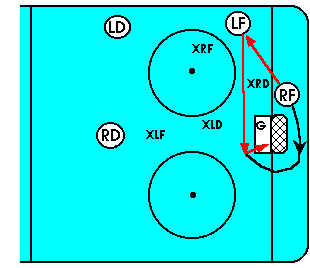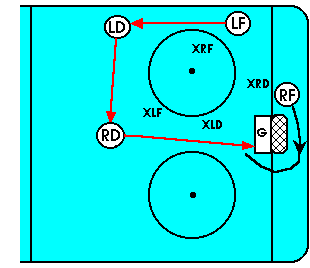Offensive Attacking (Part 2) -- by Greg Siller
An effective offensive zone attack is built upon two stages. The first stage
involves moving the puck into the offensive zone (covered in Part 1). If the
first stage does not produce a good scoring opportunity, your team needs to
implement the second stage. This second stage consists of maintaining
possession of the puck in the offensive zone to get that good scoring
opportunity. The strategy for maintaining the puck in the offensive zone
involves the same six factors required to move the puck into the offensive
zone, namely: puck control and movement, positioning of non-puck carrying
players with respect to the puck carrier/shooter, defined plays with
improvisation, shots on net from a high percentage scoring location, patience,
and reading, reacting, and anticipating.
Three techniques that a team can use to score more goals while maintaining
possession of the puck in their offensive zone include puck control down deep
with an eventual pass across the slot, shot from the point, and a slot shot by
the center or a descending defenseman.
 During an offensive attack, a pass
across the slot can be a very effective way to score. This type of play
works due to the quick lateral movement of the play (and the puck). The first
figure shows the execution of this type of play in which the right forward (RF)
has control of the puck down low. RF passes the puck to LF and then moves away
from the play. With the puck along the left side of the rink (and most of the
attention focused there), RF skates behind the net to avoid his coverage and
positions himself on the far side of the net. LF maintains control the puck
until RF is open and then executes a pass across the slot for a quick shot on net
and a goal!
During an offensive attack, a pass
across the slot can be a very effective way to score. This type of play
works due to the quick lateral movement of the play (and the puck). The first
figure shows the execution of this type of play in which the right forward (RF)
has control of the puck down low. RF passes the puck to LF and then moves away
from the play. With the puck along the left side of the rink (and most of the
attention focused there), RF skates behind the net to avoid his coverage and
positions himself on the far side of the net. LF maintains control the puck
until RF is open and then executes a pass across the slot for a quick shot on net
and a goal!

The second figure shows the execution of a shot from the point. As with
the previous example, rapid puck movement is essential. The puck is moved down
deep in the offensive zone by the left forward (LF) to the strong-side
defenseman (LD) and quickly over to RD. This rapid puck movement does not allow
the defenders time to get set up to properly cover the offensive team. Once RD
has the puck, he executes a low shot from the point as the right forward moves
out from behind the net to the front of the net. If the initial shot does not
go in, RF is in the right location for a rebound.

The third figure, shows what can happen when the defending players collapse on
the puck carrier. While LF has the puck in the lower corner, the defenders are
seen collapsing on him in an attempt to regain control of the puck. RD reads
the play and reacts by moving toward the slot in anticipation of a pass from
LF. As LF sees RD moving in, he passes the puck to him for a quick shot on net.
Both RD and RF are in excellent position for a rebound.
Maintaining control of the puck, using the six offensive zone strategy factors
described above, will give your team the edge it needs to consistently work
your offensive zone attack and score more goals. Practice these techniques and
watch your offense improve!
Contact Greg Siller @ Pro Learning
Systems